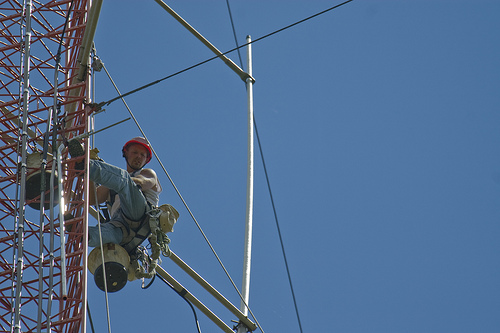‘No more falling workers’: OSHA raises alarm over cell tower deaths
The average fatality rate of the U.S. cell tower industry is on the rise. Thirteen deaths were reported in 2013 and four communications tower workers have already died in 2014. The Occupational Safety and Health Administration (OSHA) has expressed concern over these alarming numbers, and is now urging the industry to comply with strict tower safety practices to prevent cell tower deaths.

A worker climbs up a radio tower to install upgraded equipment. This photo was taken when he was almost 200 feet up the tower.
More communication tower deaths than in construction industry
Due to a high demand for wireless and broadcast networks, communication towers have been sprouting up like giant weeds across the landscape. In order to maintain and upgrade the ever-increasing cellular infrastructure, workers regularly climb these communication towers, where heights range from 100 feet to as high as 2000 feet, even during adverse weather conditions.
Tower worksites are home to several fatal hazards. The greatest risks to workers are falls from great heights, equipment failure, and even the structural collapse of towers. A study by ProPublica and PBS “Frontline” reveals that between 2003 to 2010, the average annual fatality rate for the cell tower industry (123.6 per 100,000 workers) was 10 times greater than that of the construction industry (10.7 per 100,000 workers). Casualties reported in the year 2013 are much higher than the previous two years combined.
In-depth analysis of these deaths exposes a grim picture. Cell phone providers who employ these people pay a minimum fine and rarely come under increased scrutiny for these accidents. The company that employed Mike Rongey, a cell tower worker who plummeted to his death recently while on the job, was penalized a mere sum of $450.
Employees hesitate to raise safety issues
The problem of worker fatality gets more complex because of the intricate nature of cell tower ownership and subcontracting for the construction and maintenance of communication towers. The utility company erecting the tower may hire one company to get the work done in a particular market or city, and that company may in turn subcontract to a third party if on a tight schedule.
Also, demands to upgrade infrastructure opens the scope for temporary workers. Under pressure to meet deadlines, and with a temporary or transient workforce, some workers may flout rigorous safety standards while rushed bosses will turn a blind eye. Most of these workers hesitate to raise safety concerns with their employers for the fear of being blacklisted from future jobs. Wally Reardon, project coordinator for the Workers at Heights Safety and Health Initiative (affiliated with the Occupational Health Clinical Center in Syracuse, New York) believes that if large companies with big assets and brands are held accountable, safety would improve by 100 percent.
OSHA’s outreach initiative to curb cell tower deaths
In order to put a stop to these tragic incidents, OSHA has come up with strong outreach initiatives to ensure tower safety. Dr. David Michaels, assistant secretary of labor for OSHA, says, “Tower worker deaths cannot be the price we pay for increased wireless communication. Employers and cell tower owners and operators must do everything possible to stop these senseless, preventable tragedies.”
OSHA has urged employers to ensure strict safety adherence to stop these preventable deaths. In a letter to the communication tower industry, the agency has specified some guidelines to safeguard employee health and safety.
“We are also looking at the structure of this industry and the multiple levels of subcontracting, from the giant telecoms to the small companies who employ the workers maintaining the towers. We are calling on everyone in the industry – from the major cell carriers to the owners of the towers, from the tower maintenance companies down to the small firms who employ the climbers – to take responsibility for worker safety. We will be collecting and analyzing contracts and asking the hard questions right up to the top.”
–Dr. David Michaels, assistant secretary of labor for OSHA
OSHA has also created a webpage that provides compliance assistance and information regarding cell tower safety. The agency is collaborating with The National Association of Tower Erectors to make certain that employers understand their responsibility of safeguarding workers performing this high-hazard job. Organizations that deal with high hazard worksites can avail OSHA’s free on-site consultation program for professional assistance.















